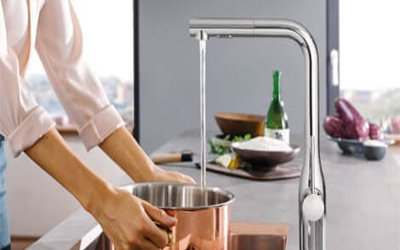
How to Fix a Leaking Tap
A leaking or dripping tap is one of those annoyances that every now and then comes along to keep us on our toes and test our DIY maintenance skills.
If you are more of a novice then perhaps knowing where to start to resolve the issue can seem like a mind field but don’t despair our simple to follow Building Supplies Online ‘how to fix a leaking tap yourself’ guide is here to assist you along the way.
When you identify a leaking tap, try to fix the problem as soon as possible to prevent water damage on surrounding surfaces and walls as well as preventing too much water being lost resulting in wastage and higher bills if left for a significant amount of time.
You will need the following tools to fix your leaking tap:

- An adjustable spanner
- A screwdriver (either a cross or flat head should be fine)
- A cloth to soak up any water
Firstly, you will need to identify the type of tap you have as this will determine how to rectify the leak. The main two types of taps are Traditional and Monobloc (newer) taps (Monobloc taps control both temperature and flow of water from the tap with the movement of one handle). The cause of traditional taps leaking is often because the rubber washer has eroded and needs to be replaced which is simply replacing a rubber washer. With monobloc taps, the cause may be because of its unique ceramic cartridge needing to be replaced. The ceramic cartridge would usually need to be pre-ordered from a retailer however this only needs replacing usually every 12-15 years.
Shop our range of Kitchen Taps Here
Before starting to rectify the problem the most important thing to do is to:
- Turn off your water supply to your tap by following the pipes underneath your sink connected to your taps and locating the ‘isolation valve’. This will be a small handle/lever, turn to shut off the water going to your tap. Alternatively, turn water supply off by turning your main stop cock off. If you don’t know where this is in your house, it’s truly advisable to find out in case you need to know for a further and bigger emergency in the future.
- Turn your kitchen or bathroom tap on to rid of any remaining water in the pipes between your tap and the isolation valve.
- This bit is very important too; place your sink’s plug into the sink hole so if you drop a washer or screw in the following steps, it won’t go down the drain potentially delaying you in fixing your leaking tap.
- The next step is to source the screw located on the tap itself of which keeps your tap together in one piece. In a traditional tap, the screw will usually be under the brand or decorative plaque on top of the tap. Remove the plaque to locate. In Monobloc Lever taps you will usually find a screw exposed on the tap handle so once found, use your screwdriver to remove.
- Now you can remove the head of the tap and you will see a spindle or a valve.
- You can now use your adjustable spanner to hold the central nut still whilst unscrewing the spindle. Doing this will help prevent the tap itself from twisting causing the pipes beneath the sink to bend causing damage. Remove the top and bottom round washers. When you buy washers, they will be in packs so when you are changing one washer it makes sense to change both washers at the same time as we both be worn anyway eliminating the need to repeat this process again in a few months.
- When you have replaced both the top and bottom washer, assemble the tap together again, followed by turning your isolation valve (or the stop cock if you used this to turn your water off initially) the opposite way to turn your water supply on again.
- If you have a monobloc tap, then it won’t simply be a matter of changing the top or bottom washer. The monobloc taps are far more advanced than traditional taps and so you will need to contact the supplier of your tap to order the appropriate new cartridge. This is due to monobloc taps using significant new ceramic disc technology.
- In traditional and older taps if after changing the washer you find the leak persists you will need to check the seals and the O-Rings also. These again are simple and cheap to replace.
A good tip to prevent your washers from wearing out so often is to not turn your taps too tightly when turning your taps off as this puts strain on to the washer itself allowing them to give a way each time.
At Building Supplies Online, we stock a large range of tap accessories for any job big or small at competitive prices and fast delivery.
